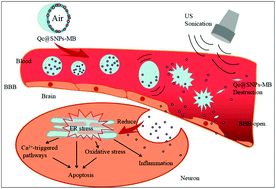Microbubbles in combination with focused ultrasound for the delivery of quercetin-modified sulfur nanoparticles through the blood brain barrier into the brain parenchyma and relief of endoplasmic reticulum stress to treat Alzheimer's disease†
Abstract
The delivery of drugs across the blood–brain barrier (BBB) effectively and safely is one of the major challenges in the treatment of neurodegenerative diseases. In this work, we constructed a nano-system using microbubbles to promote the crossing of drugs across the BBB, where microbubbles in combination with focused ultrasound were used to mediate the transient opening of the BBB and delivery of nanomedicines. This system (Qc@SNPs-MB) was formed by embedding quercetin-modified sulfur nanoparticles (Qc@SNPs) in microbubbles (MB). Qc@SNPs-MB was destroyed instantly when exposed to ultrasonic pulses, and it enhanced the permeability of the blood vessels, resulting in the brief opening of the BBB owing to the “sonoporation” effect. Also, Qc@SNPs were released from the outer shell of the microbubbles and entered the brain across the open BBB, accumulating in the brain parenchyma. Due to the rapid accumulation of Qc@SNPs in the brain, it effectively reduced neuronal apoptosis, inflammatory response, calcium homeostasis imbalance, and oxidative stress, which are all mediated by endoplasmic reticulum stress, and protected nerve cells, thus treating Alzheimer's disease (AD) effectively. The Morris water maze experiment showed that the learning ability and memory ability of the AD mice treated with Qc@SNPs were significantly improved, and no obvious side effects were found. Therefore, Qc@SNPs-MB combined with ultrasound can provide an effective and safe drug delivery method for the treatment of neurodegenerative diseases and a promising strategy for endoplasmic reticulum stress therapy.



 Please wait while we load your content...
Please wait while we load your content...